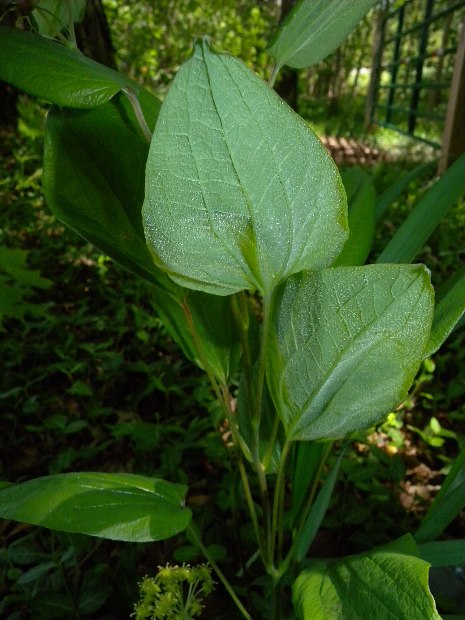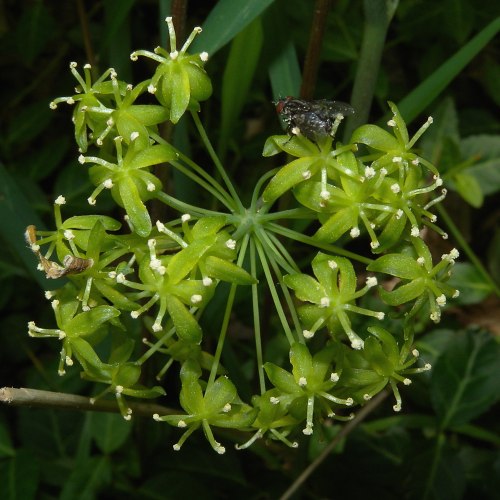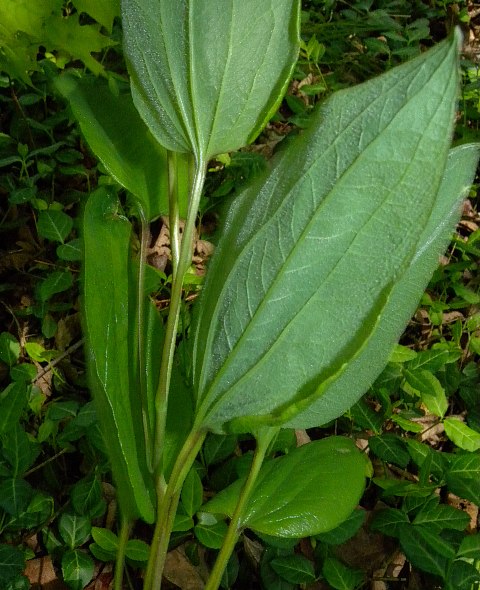
Each umbel has 15-45 flowers on slender pedicels (floral stalklets). Because this plant is dioecious, some plants produce only male (staminate) flowers, while other plants produce only female (pistillate) flowers. Each male flower has 6 yellowish green or green spreading tepals and 6 stamens with whitish or yellowish anthers. Each female flower has 6 yellowish green or green spreading tepals and a green central ovary with 3 prominent stigmas. The tepals of both male and female flowers are elliptic, oblong-lanceolate, or oblong-oblanceolate in shape. Both male and female flowers are 6-8 mm. (1/4"–1/3") across. The blooming period occurs from late spring to early summer, lasting about 3 weeks. The flowers have a mild carrion-like odor. Afterwards, the female flowers are replaced by berries. At maturity, these berries are 6-8 mm. (1/4"–1/3") across, blue-violet, and globoid in shape. The interior of each berry is juicy and contains 1-5 seeds. The root stock is tuberous.
Cultivation: The preference is partial sun to light shade, moist to mesic conditions, and loamy soil with ample amounts of organic matter. Growth and development are very rapid during the spring, but once the flowers and immature fruits are produced, there is little new growth.

Range & Habitat: Illinois Carrion Flower (Smilax illinoensis) is widely scattered throughout Illinois, where it is native and uncommon (see Distribution Map). Habitats include woodlands in river valleys, wooded areas along roads, and thickets. Southern Illinois lies along the southern range-limit for this species, which occurs primarily in the Upper Midwest in the Great Lakes region (eastern Minnesota, Wisconsin, Michigan, and northern Illinois). Illinois Carrion Flower is found in both higher quality natural areas and more degraded habitats with a history of light to moderate disturbance. It probably benefits from occasional wildfires.
Faunal Associations: The nectar and pollen of the flowers attract many kinds of flies, including blow flies (Calliphora spp., Lucilia spp.), Muscid flies, and flesh flies (Helicobia spp., Sarcophaga spp.). Halictid bees and miscellaneous beetles also visit the flowers to a lesser extent. Various insects feeds on the foliage or suck plant juices from Smilax spp. (Greenbrier, Carrion Flower). These insect species include Neoprociphilus aceris (Woolly Maple Aphid), the larvae of gall flies (Cecidomyiidae), the larvae of several moths, and others (see the Insect Table for more information). White-tailed Deer like to browse on the foliage of Smilax spp., especially non-thorny Carrion Flower species. Mammals that eat the berries include the Virginia Opossum, Raccoon, Fox Squirrel, and American Black Bear. In addition, the berries are often eaten by such upland gamebirds and fructivorous songbirds as the Cedar Waxwing, Northern Cardinal, Gray Catbird, Veery, Hermit Thrush, American Robin, Ruffed Grouse, and Wild Turkey. The Ruffed Grouse and Wild Turkey also feed on the young leaves (see Bird Table).

Photographic Location: A wooded area near a river and a roadside in rural Champaign County, Illinois.
Comments: Illinois Carrion Flower (Smilax illinoensis) was not recognized as a distinct species until 1968. It has characteristics that are intermediate between the Common Carrion Flower (Smilax lasioneuron) and Upright Carrion Flower (Smilax ecirrhata). It is possible that Illinois Carrion Flower is a naturally occurring and well-established hybrid between these two species. Common Carrion Flower is a sprawling vine up to 8' long that produces abundant tendrils. It has petioles that are shorter than the leaf blades and its umbels tend to have more flowers or fruits than those of Illinois Carrion Flower. Upright Carrion Flower can be distinguished by its slightly wider leaves that have blunt tips and slightly cordate bases. The petioles of its leaves are shorter than the blades. This latter species never produces tendrils, it tends to be a little shorter in height, and its umbels tend to have fewer flowers (usually less than 20). In contrast, Illinois Carrion Flower has leaves with more tapered acute tips and rounded to truncate bases; its petioles are usually as long or longer than its leaves, and its umbels usually have 20 or more flowers.